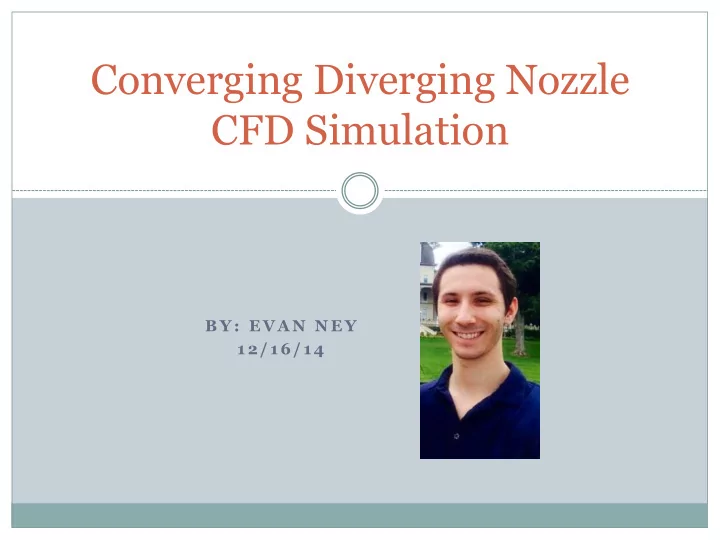

Converging Diverging Nozzle CFD Simulation B Y : E V A N N E Y 1 2 / 1 6 / 1 4
Converging Diverging Nozzle - Background Hour glass shaped nozzle HIGH Fully subsonic isentropic flow Velocity increases in converging section and decreases Inlet of decreasing cross sectional area in diverging section Outlet of increasing cross sectional area Flow becomes choked (Mach 1 at throat) Upper limit of back pressure range for shocks Used to accelerate pressurized fluid to Converging section becomes time independent Outlet (Back) Pressure supersonic speeds Normal shock wave is formed near throat Instantaneous property changes across shock Useful in many turbine and jet engine Pressure increase applications. Temperature increases Velocity decreases Shock wave location moves towards outlet Shock is just at outlet. More complex shock patterns begin to occur Flow pressure at exit is less than ambient pressure – Overexpanded nozzle Fully supersonic isentropic flow (design condition) Lower limit of back pressure for shocks in overexpanded flow Back pressure low enough that it equals the nozzle exit pressure Shocks disappear 𝒆𝑩 𝑩 = 𝒆𝑾 𝑾 (𝑵 𝟑 − 𝟐) LOW Reference 1
Project Aims This project aims to This project aims to 1) 2) examine inviscid and examine viscous real flow in a 3D boundary layer supersonic converging separation with shock diverging nozzle and waves in an over the development of expanded supersonic normal shocks in the nozzle. nozzle.
Geometry and Mesh Geometry Best mesh: The nozzle profile will aligned Profile: with that tested by Craig Edge sizing with number of Hunter, NASA (profile depicted divisions per section below) Bias towards wall Sweep: Throat area At =4.317 in^2 Swept through the width with Expansion ratio Ae/At = 1.797 bias towards edges Width 3.99in Mirrored over symmetry plane
ANSYS Fluent Setup INVISCID MODEL TURBULENT MODEL Solver Settings: Solver Settings: Steady solver Steady solver Density based (as the flow is compressible) Density based (as the flow is compressible) Inviscid model K-Epsilon/K-Omega 2 nd order upwind 2 nd order upwind/1 st order upwind Boundary conditions: Boundary conditions: Pressure inlet at inlet Pressure inlet at inlet Pressure outlet at outlet Pressure outlet at outlet No slip wall on sides and top plane No slip wall on sides and top plane Symmetry on bottom plane of model Symmetry on bottom plane of model Material Properties: Material Properties: Working fluid was standard air Working fluid was standard air Air as ideal gas model Air as real gas (Soave Redlich Kwong) NPR = inlet total pressure / outlet pressure
Inviscid Results Mach: Mach : NPR 8.78 NPR 1.4 (isentropic) (shock)
Turbulent Results Pressure Comparison Solver Study Mesh 3 vs Empirical NPR 1.4 NPR 2.0 Velocity NPR 2.0 NPR 3.0
References http://www.ivorbittle.co.uk/Books/Fluids%20boo 1. k/Chap[6pter%2013%20%20web%20docs/Chapte r%2013%20Part%203%20Complete%20doc.htm 2. http://www.engapplets.vt.edu/fluids/CDnozzle/cdi nfo.html Hunter, Craig A. “Experimental Investigation of 3. Separated Nozzle Flows.” Journal of Propulsion and Power No. 3 Vol. 20. (2004)
Recommend
More recommend